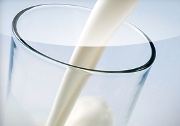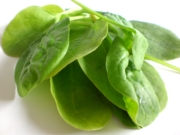Foods That Are Most Prone to Radioactive Contamination
The unfolding nuclear disaster in Japan has now extended to the nation's food chain. On Saturday, the Japanese government announced that it had found abnormally high levels of radioactive iodine-131 (I-131) in spinach and cow's milk. Higher-than-standard levels of I-131 have also been detected in garland chrysanthemum, a leaf vegetable also known as tong hao (in China) and shungiku (in Japan). In the medium and long term, also many other foods — in particular wild mushrooms and berries — stand the risk of becoming contaminated with radioactive substances, such as cesium 137 and strontium 90. Also lettuce, leeks, goat's milk and sheep's milk are known to be particularly sensitive to contamination with radioactive material.
Raw Milk, Especially Goat's and Sheep's Milk

The contaminated milk was found in Fukushima Prefecture on farms about 20 miles from the damaged nuclear reactors. Japanese food safety and health officials reported that the iodine-131 (I-131) found in the tested milk was up to five times the level the government considers safe. Iodine-131, with a half-life of eight days, is a radioactive isotope that is released when a nuclear power plant melts down, when nuclear weapons are produced or when an atomic/ nuclear bomb is detonated. Iodine-131, if inhaled or swallowed, concentrates in the thyroid gland where it can accumulate and cause tumors and cancer within a short period of time. Populations exposed to iodine-131 also have an elevated risk developing thyroid disease. The risk of cancer and thyroid problems is higher for children than for adults as children typically have more active thyroids.
Raw milk is one of the foods that are most likely to become contaminated by radioactive iodine as livestock feeds on grass which is particularly prone to radioactive contamination during nuclear disasters. Goat's milk and sheep's milk appear to be particularly sensitive to contamination as goats and sheep feed on plants that have a low water (are more concentrated). Goat's milk and sheep's milk have been reported to contain approximately 10 times the concentration of radioiodine found in cow's milk. Note: In regions not contaminated by radioactive iodine, milk and dairy products are an important source of stable iodine, a nutrient that is crucial for the proper functioning of the human body. Stable iodine should not be confused with radioactive iodine-131.
In addition to being sensitive to I-131 contamination, milk may be affected by radioactive isotopes of strontium at the event of a nuclear disaster. Strontium, more specifically strontium-90, has a half-life of 28 years, and like dietary calcium it is mainly deposited in teeth and bones when it enters the human body. As new blood is formed in the bone marrow, strontium is considered a catalyst of leukemia.

Spinach, Garland Chrysanthemum, Lettuce and Leeks
The radioactive spinach in Japan was found in Ibaraki Prefecture on farms 60 to 90 miles from the ravaged nuclear power plants. The level of radioactivity found in the tainted spinach, if consumed for one year, would equal about one-fifth of radiation received in a CT scan (a CT scan is a compressed series of X-rays used for medical tests). Also garland chrysanthemum, a leafy herb native to East Asia, has been found to contain elevated levels of iodine 131. The radioactive garland chrysanthemum was found in Chiba Prefecture, north of Tokyo.
But why spinach and garland chrysanthemum? The reason is simple: Spinach and other leafy vegetables and herbs are among the first foods to be contaminated by radioactive deposits at the event of a nuclear disaster because the leaves of these vegetables can directly capture radioactive substances from the air. Spinach was also one of the first foods reported to be contaminated during the Chernobyl disaster in 1986. Other vegetables that were found to contain particularly high levels of radioactive substances in May 1986 included lettuce and leeks. Cabbage and other leafy vegetables that do not have leaves spread out may be less likely to collect large amounts of particles from the air.
Mushrooms
As of March 21, 2011, Japanese health and food safety officials have reported abnormal levels of radioactive substances in milk, spinach and garland chrysanthemum (and slightly elevated levels in drinking water in some areas). However, there are a number of other foods that are particularly prone to becoming affected by radioactive substances released by faulty nuclear power plants. Wild mushrooms are one such food. Mushrooms, which use absorption to obtain nutrition from the atmosphere, are prone to accumulating radioactive substances such as cesium-134 (134 Cs), cesium-137 (137 Cs) and other radionuclides. Cesium-134 has a half-life of approximately 2 years, while cesium-137 has a half-life of 30 years! Radiocesium can damage human DNA and ultimately result in cancer.
Berries
After the Chernobyl disaster in mid 1980s, abnormally high levels of radiocesium were found in many berries in several European countries. These berries included bilberries, cranberries, cloudberries, blackberries and wild strawberries. As the half-life of cesium-137 is 30 years, berries contaminated by this radioactive substance are still found in certain regions in Europe. However, in most cases, the level of radioactivity detected is very low.

